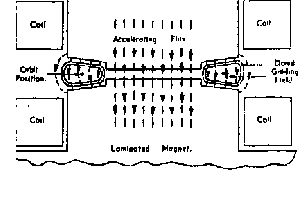The betatron
Unlike other particle accelerators, the name of the betatron does not tell us anything about how it works, but it is best thought of as a transformer, with a ring of electrons as the secondary coil. The magnetic field used to make the electrons move in a circle is also the one used to accelerate them, although the magnet must be carefully designed so that the field strength at the orbit radius is equal to half the average field strength linking the orbit:
![]()
If the magnetic field increases, there is a changing flux linking the loop of electrons and so an induced e.m.f. which accelerates the electrons. As the electrons get faster they need a larger magnetic field to keep moving at a constant radius, which is provided by the increasing field – the effects are proportional, so the field is always strong enough to keep the electrons in orbit!
The field is changed by passing an alternating current through the primary coils and particle acceleration occurs on the first quarter of the voltage sine wave’s cycle. Although the last quarter of the cycle also has a changing field that would accelerate the electrons, it is in the wrong direction for them to move in the correct circle! The target is bombarded with pulses of particles at the frequency of the ac supply.


The particles have maximum energy when the magnetic field is at its strongest value but the formula used for the cyclotron will not work for betatrons because the electron will be relativistic. However, if the total energy is much greater than the rest energy then E = pc is a good approximation. As the centripetal force is again provided by the Lorentz force,
![]()
the maximum momentum will be ![]() and hence
and hence ![]()
An example of this type of machine is the University of Chicago’s 315 MeV betatron, built in 1949. With a magnetic field strength of 0.92 T and orbit radius of 1.22 m, the calculated energy is 340 MeV, in reasonable agreement, as synchrotron radiation losses have not been taken into account. (see section on synchrotrons)
The formula for the electron’s momentum can also be derived from Faraday’s law of electromagnetic induction.
![]()
where N = 1 and A = pr2.
Converting from voltage induced to electric field strength using E = V/d gives
![]()
and so
![]()
The force on the electron will be given by ![]() so
Newton’s second law of motion gives
so
Newton’s second law of motion gives
![]()
and integrating gives
![]() as before.
as before.
Betatrons are still used in industry and medicine as they are the very compact accelerators for electrons. Cyclotrons are similarly compact but cannot accelerate electrons to useful energies.
Introduction Direct voltage and cascade machines Cyclotrons
Betatrons Linear accelerators and the synchrocyclotron Synchrotrons
Fixed target verses collider machines Lepton verses Hadron machines The Future?